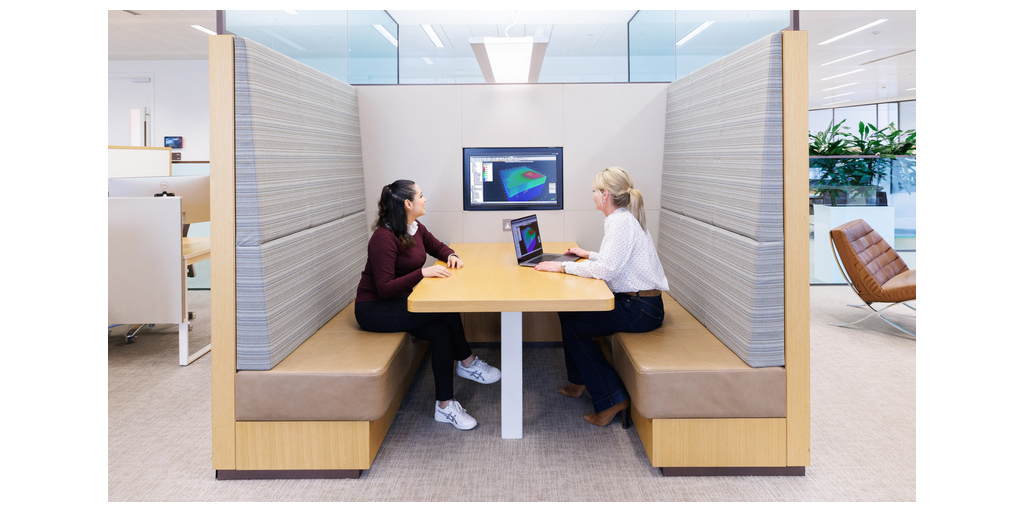Sign up for daily news updates from CleanTechnica on email. Or follow us on Google News!
In the past year I’ve been observing a trend that’s on at least a couple of continents. Delivery trikes now come without boxes of their own. The boxes are separate and they get packed in distribution centers with the intent of being delivered to a pickup point for an electric urban trike. The boxes even have their own wheels, although just small ones like the front wheels of shopping carts. It’s interesting to think about the implications of this, so follow along.
We live, of course, in the world of The Box, by which I mean standard-sized shipping containers. The standard measure of container ship capacity is the TEU, or twenty-foot equivalent, which has the following dimensions: length of 6.10 meters (20 feet), width of 2.44 meters (8 feet), and height of 2.59 meters (8 feet 6 inches). They are made of corrugated steel with reinforced edges and corners. They have standardized holes in the corners on the top and bottom which allow them to be both picked up from above by reach stackers and straddle carriers in transshipment terminals and locked together when stacked on the ground, on train cars or on ships.
In the 1950s, shipping was a messy business. Goods were loaded and unloaded piece by piece, which was slow and prone to damage and theft. Enter Malcolm McLean, a trucking magnate with a big idea and a primary subject of the recommended book, The Box: How the Shipping Container Made the World Smaller and the World Economy Bigger. In 1956, he invented the shipping container, a standardized steel box that could be easily transferred between trucks, trains, and ships.
The first container ship, the Ideal X, set sail in 1956, carrying 58 containers from Newark to Houston. The concept quickly caught on. By the 1960s, ports around the world were adapting to handle these new containers, leading to the creation of container terminals and specialized cranes. It took a while before they standardized and competition found a close enough approximation to an ideal size. Even now they come in multiple lengths, with 18.3 meter (60 foot containers) available although rarely used.
Now ships capable of carrying 24,000 TEUs carry an estimated 866 million of them across oceans every year. Many categories of products which used to be bulks have been containerized for efficiency of handling at all levels.
A similar standardization has emerged in home packing pods, those miniature containers that people’s furnishings and goods end up in, sometimes sitting on driveways or moving company storage areas for days or even months. Home packing pods come in several standard sizes now. Small pods are approximately 2.4 meters long (7 feet 6 inches), 1.8 meters wide (6 feet), and 2.4 meters high (7 feet 6 inches); medium pods are approximately 3 meters long (10 feet), 2.4 meters wide (8 feet), and 2.4 meters high (8 feet); and large pods are approximately 4.8 meters long (16 feet), 2.4 meters wide (8 feet), and 2.4 meters high (8 feet). one thing that they have in common is that they all fit neatly inside TEUs and semi-truck trailers.
How far can standardized containers go in this Russian nesting dolls world?
As author William Gibson said, the future is already here, it’s just unevenly distributed. I live in his home city of Vancouver, which is a pocket of the future in many ways. One of them is the degree of electrified, small delivery vehicles all over the inner parts of the city. From two- and three-wheeled cargo bikes to more normal electric bikes to electric scooters to electric unicycles, everything from parcels to grocery to fast food arrives on silent, emissions-free machines.
Usually these devices have a rider, but while chatting with some local parkour types in Olympic Village recently, we were distracted by a two-wheeled basket full of what appeared to be groceries quietly making its way down the sidewalk — an autonomous delivery solution. Oddly, it waited at the door of the London Drugs to be let in, so it was possibly a store-to-store delivery robot for out of stock items coming from the big location a few blocks away or the one downtown.
But the focus of this are the cargo bikes. They come in a few types. Historically they were usually two-wheelers with big open bins and racks, and could carry kids, groceries, or parcels. The open bins were in front of the rider, and usually a smaller front wheel than normal bicycle wheels, 44 centimeter or 20 inches in diameter, was controlled by a somewhat complex rod system. It works fine and I’ve seen a lot of electric variants of it, including one delightful one recently where a man was pedaling while his partner and child sat in the bin along Vancouver’s Seawall. (I also find electric bike buses with 2-3 toddlers on the back a delight.)
With the advent of electric drivetrains, design parameters changed. A lot more weight and cargo became viable and wind resistance diminished as a concern. For those who haven’t biked, riding into the wind is the same as riding uphill, and riding uphill into the wind is a pain in the thighs. Riding uphill into the wind with a huge box acting as a sail just wasn’t viable until electric assist came along.
Downtown cargo trikes have been shifting to a new format, with the rider up front, riding much as if they were on a regular bicycle, with a huge box behind them with two wheels on either side. That’s been around for perhaps a decade, but the box was built into the trike.
That’s where a change is occurring. The box is no longer integral to many cargo trikes. Instead, the cargo trike has one of two or three designs of open frames. There are three to five boxes per trike, and they have small caster wheels on them like the wheels on the front of shopping carts. They can be pushed along easily on pavement or concrete.
The boxes are becoming fairly standard in size, as there’s only so much opportunity in the context of a trike that has to fit on bike paths. They are typically in the range of two cubic meters (71 cubic feet) of interior volume, a bit taller and longer than they are wide. For comparison, a Tesla Model 3, which has a lot of storage space for its class of car, has about 0.7 cubic meters of storage space. The average American SUV with all of its seats down provides a couple of cubic meters of storage space. It’s a big box.
And it’s not necessarily a light box when fully loaded. While some of the deliveries will be Cheetos in an Amazon box with protective plastic bubble wrap, loads for these boxes can be up to 300 kilograms (or 660 of those Imperial pounds Americans seem to be stuck on).
No one will be cycling up hills into the wind with one of these boxes fully loaded without an electric motor doing virtually all of the work. An elite cyclist can produce 350 watts of power for an hour, or 350 watt-hours. Riding one of these cargo trikes fully loaded uphill 50 meters on a 3% grade into a wind would take about 5 minutes at 20 kilometers per hour and take about 100 watt-hours. That’s almost four times as much energy as an elite cyclist can manage. Trivial for an electric motor, but even the most doped-up Tour de France rider would be gasping in the saddle very quickly.
The small wheels on the boxes are what make them a roro or roll-on roll-off box, by the way. Roro is a term used in freight shipping for vessels that typically carry vehicles. That can be freight trucks with their trailers or car delivery ships. Ropax refers to ships that carry both vehicles and passengers, with scheduled routes varying upon the ratio of freight to people. Anyone who has drive onto a ferry has been on a ropax vessel. Because it’s all logistics, the term roro is being applied to the cargo trike boxes as well.
They are rolled into the back of the cart, either using their wheels on tracks on either side or lifted up with effectively forklift prongs or straps with electric motors, then secured in place.
The trike rider is no longer responsible for going to a depot or truck, taking a bunch of individual parcels out and putting them in the trike box. Instead, depot workers pack the boxes according to expected routes. If the depot is downtown, when the trike rider is finished delivering the contents of one box, they ride to the depot, drop the empty box off and pick up a new box. Increasingly, however, the boxes are rolled onto trucks, also increasingly electric, and the truck driver delivers boxes to several trike riders before returning to the depot with empties to collect more and return.
This becomes an entire logistics system for last mile deliveries, with roro systems including vans spec-ed out to contain an optimum number of boxes and allow efficient loading and unloading at depots and the side of the road starting to appear. Buying the package can include a set of trikes, potentially swappable batteries, a couple of vans, depot configuration guides and route optimization software.
Sipping at electricity, zero noise, zero emissions, zero pollution, and low congestion impacts make this both almost invisible to anyone not paying attention, but very beneficial to the urban fabric.
As I said at the beginning, I’ve been noticing this online and in my downtown urban neighborhood in Vancouver for the past year. The other day I was heading down to the Seawall and one of the trikes, this one from Fedex although I know UPS is doing similar things, was backing into a spot to deliver to one of the residential buildings on the waterfront. Yes, electric cargo trikes have a reverse gear. I took a closer look and sure enough, the box on the back had its own wheels, suspended off of the pavement by one of the mechanisms I mentioned earlier, although I didn’t inspect it closely enough to determine which Fedex is using locally.
I stopped to chat with the delivery person to get his take on it. Sure enough, other people pack it, he drops off empties and picks up full ones. There’s an attempt at route optimization in selecting packages for the box and the order in which they are put in the box to optimize the delivery person’s time. It often falls apart because last-mile package operations often include rush jobs, so in his experience it was a bit mixed on any given day. Not putting the packages in himself meant digging through the packages to find the right ones for a building. Definitely a gain, but not as big a gain in reality as in theory.
There’s one additional factor that makes this a bit less of a slam dunk. When Canada Post or Amazon delivery people show up at downtown condos, they bring a big fabric bin — Amazon’s are made of fabrene, collapsible into a flat unit and are dragged along the ground, while Canada Post’s are light canvas bins on wheels — to the door full of all the parcels for the building in one delivery. They load the bins from their trucks which they park in a neighborhood like mine and service building after building from the single truck, often taking an hour to get all parcels delivered. The Amazon delivery people drag the bin to each floor or just leave it in the lobby, while Canada Post frequently buzzes multiple residents to come down to collect their parcels. This is undoubtedly more efficient than cargo trikes with standardized roro boxes.
My neighborhood, on the other hand, is one of the most densely populated in North America, with about 3,000 residents on my small block alone, and a census tract containing 34,000 people that I can walk around the bounding streets of in under 15 minutes. It’s the most densely populated in Vancouver, as well. The van being a mobile depot for foot delivery of parcels makes the most sense here.
Further, I’ve seen UPS delivery vans and UPS cargo trikes parked together in the alley behind my building, loading the trike for more spread out deliveries while the drive is aligned with the densest set of packages to buildings like mine.
To the point of the two-wheeled little cart of what appeared to be groceries rolling down the sidewalk on the other side of False Creek, much of this is going to end up autonomous in the future, something Anthony Townsend, author of Ghost Road: Beyond the Driverless Car, and I discussed four years ago at the beginning of the COVID pandemic. His work was focused on the future of urban logistics, an absolutely critical space.
One pattern that will likely emerge is riderless autonomous vehicles that take full boxes from depots to connect with delivery people on their rounds. Empty and full boxes will shuttle themselves too and from the depot, and the delivery person will handle the last 10 meters. Another pattern that will emerge is boxes with electronic lockers, like Amazon pickup lockers today, but with wheels. They’ll arrive outside a building and text the recipient, who will take the elevator down, plug their code into the container or more likely unlock it with an app, take their parcel and head inside — the Canada Post model but without the postal worker. (I don’t expect that the unionized staff at Canada Post will feel all that warmly about the idea). Where there’s density, the unit will service half a dozen or a dozen residents at once. Flying drones may get the buzz, but small wheeled vehicles will be making all the deliveries.
One of the things Townsend and I discussed was the potential for post-Covid retail stores becoming urban micro-depots for this type of thing. While diesel semi deliveries are often prohibited from dense areas overnight due to noise pollution, electric semis don’t face this restriction. Overnight deliveries from exurban distribution warehouses to micro-urban depots for next day autonomous or semi-autonomous low-speed delivery becomes entirely viable. Amazon deliveries in my neighborhood are already up to 10 PM in the evening seven days a week, and quiet wheeled package delivery drones will be providing more and more of that.
Most of North America is spread far and wide, making delivery by low-speed autonomous vehicles trundling along bike paths and sidewalks — where they exist at all — impossible. That’s not true for much of cities like Vancouver, Toronto, Boston, New York, and San Francisco. The rest of the world has vastly less sprawl. As I pointed out recently in my assessment of the most likely pathway for freight tonnage dominance and decarbonization in North America — electric trucks — 92% of North American weekday trips are by car, while in Europe it’s 45%, and in Asia it’s 30%.
In this context of much denser living conditions in the rest of the world with North America being the deep outlier, low speed, electrified, and increasingly autonomous vehicles are going to be the norm, not the outlier. The standardized roro box is part of a continuum of evolution of last mile logistics, in other words, not the end point.
Have a tip for CleanTechnica? Want to advertise? Want to suggest a guest for our CleanTech Talk podcast? Contact us here.
Latest CleanTechnica.TV Video
CleanTechnica uses affiliate links. See our policy here.





